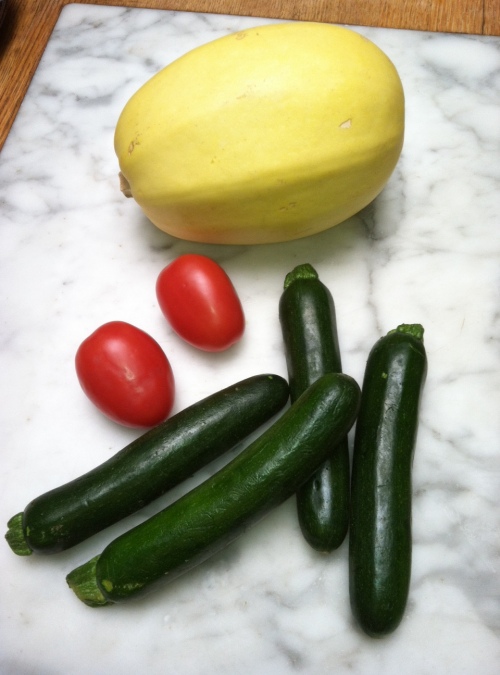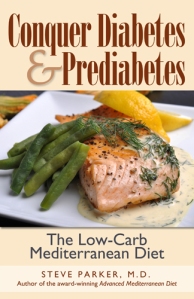
These can be part of a low-carb vegetarian diet
The answer to the headline question is: Maybe.
I was surprised to learn that well-known diabetes writer David Mendosa (Type 2 DM) has switched from a very low-carb diet to a low-carb vegetarian diet, eating no more than 50 grams/day of carbohydrate. Why?
For me the issue is that I don’t want to be responsible for harming sentient beings as much as I can avoid it while still following a healthy diet.
I respect that sentiment.
I’m sure David is monitoring the effects of the diet on his blood sugars and weight. Probably his blood lipids, too.
It sounds like all David had to do was drop fish from his prior diet. He still eats eggs (whites only?), cheese, and full-fat yogurt, so I’d call him a lacto-ovo-vegetarian.
If you’re already convinced that you know the perfect diet for people with diabetes, read no further.
What Is a Vegetarian Diet?
From UpToDate.com:
Vegetarian diets vary considerably depending on the degree of dietary restrictions. According to the strictest definition, a vegetarian diet consists primarily of cereals, fruits, vegetables, legumes, and nuts; animal foods, including milk, dairy products, and eggs generally are excluded. Several less restrictive vegetarian diets may include eggs and dairy products. Some vegetarian diets may be grouped as follows:
●Macrobiotic — Vegetables, fruits, legumes, and seaweeds are included in the diet, while whole grains, especially brown rice, are also emphasized. Locally-grown fruits are recommended. Animal foods limited to white meat or white-meat fish may be included in the diet once or twice a week.
●Semi-vegetarian — Meat occasionally is included in the diet. Some people who follow such a diet may not eat red meat but may eat fish and perhaps chicken.
●Lacto-ovovegetarian — Eggs, milk, and milk products (lacto = dairy; ovo = eggs) are included, but no meat is consumed.
●Lactovegetarian — Milk and milk products are included in the diet, but no eggs or meat are consumed.
●Vegan — All animal products, including eggs, milk, and milk products, are excluded from the diet. Some vegans do not use honey and may refrain from using animal products such as leather or wool. They also may avoid foods that are processed or not organically grown.
A 2012 poll estimated that 7% of U.S. adults eat at least one meal a week that does not include meat, fish or poultry, 4% do not eat meat, fish, or poultry, and 1–2% do not eat meat, fish, poultry, dairy products, or eggs. Roughly 5% of individuals in the UK, Germany, and Australia describe themselves as vegetarian.

Are Vegetarian Diets Safe?
Vegetarians need to be careful to get enough high-quality protein, iron, vitamin B12, vitamin D, and perhaps calcium. B12 comes only from animal products, as far as I know. You can make vitamin D by exposing your skin to sufficient sunlight. Some vegetarians will need to consult a dietitian to ensure adequate nutrition. (BTW, all my comments about vegetarian diets apply to adults only—I don’t treat children, so I’m not up-to-date on their nutritional needs.)
I’ve written about vegetarian diets for diabetes before: here and here. Dr. Michael Greger couldn’t convince Dr. Harriet Hall (or me) that we should avoid eating all animal products.
The Grashow Question
Someone claiming to be Charles Grashow left a comment on one of my blogs:
As I’ve posted before, this [vegetarian macrobiotic diet] took Insulin Dependent T2D [patients] OFF MEDS within 21 days!
Seems much better – but then again this diet is vegan not paleo!
http://www.hoajonline.com/internalmedicine/2052-6954/2/3
Ma-Pi 2 macrobiotic diet intervention during 21 days in adults with type 2 diabetes mellitus, Ghana 2011
http://www.nutritionandmetabolism.com/content/11/1/39
The effect of the macrobiotic Ma-Pi 2 diet vs. the recommended diet in the management of type 2 diabetes: the randomized controlled MADIAB trial
http://www.hindawi.com/journals/jnme/2012/856342/
Medium- and Short-Term Interventions with Ma-Pi 2 Macrobiotic Diet in Type 2 Diabetic Adults of Bauta, Havana
SO – my question is this. Why do you not recommend this type of diet instead? Or does it not fit into your paradigm?
I responded:
Charles, that macrobiotic Ma-Pi 2 diet looks like it has significant potential. I quickly scanned your first link only. For those not familiar with the diet, here’s a description from your first link:
“Vegetarian Ma-Pi 2 macrobiotic diet, designed especially by Mario Pianesi for treating diabetic patients. Total volume of the Ma-Pi 2 diet consisted of 40–50% whole grains (rice, millet and barley), 35–40% vegetables (carrots, savoy cabbage, cabbage, chicory, onions, red radish, parsley), and 8% legumes (adzuki beans, chickpeas, lentils, black beans). As a complement we used gomasio (roasted ground sesame seeds with unrefined sea salt), fermented products (miso, tamari, umeboshi) and seaweeds (kombu, wakame, nori). Bancha tea (theine-free green tea) was the main liquid diet.”
“The assayed Ma-Pi 2 diet is lower in energy than the traditional one recommended for diabetic patients, but safe, with adequate satiating effect due to the high fiber content, adequate in protein (12% of the total energy), with an acceptable amino acid score, low in fat (15% of the total energy), and high in complex carbohydrates (73%). The diet has a high antioxidant capacity and a high content of bioactive compounds with recognized functional properties (Table 2). Foods were elaborated by culinary macrobiotic specialists from UPM, Italy, and offered at the hospital during breakfast, lunch, dinner and snacks. Unfortunately, the variety of vegetables was restricted because of limited availability.”
I wonder if that would be deficient in vitamin B12.
It looks like it would be worth a try for a type 2 diabetic under medical supervision (some risk of hypoglycemia). I’d like to try a few meals with those ingredients, some of which I’ve never heard of, prepared by someone who knows what they’re doing. Unless I missed it in the link, it might be hard for the average person to replicate that study diet. If I understood correctly, the study participants stayed in a hospital for three weeks and meals were prepared for them.
I don’t have time to hit the other links right now.
-Steve
My Current Stance on Vegetarian Diets For Diabetes
I say “current stance” because I’ll change my mind based on scientific evidence as it becomes available.
I’m not convinced that any of the vegetarian diets is clearly superior to the other available “diabetic diets” in terms of quality of life, longevity, and avoidance of diabetes complications.
We have some evidence that some vegetarian diets may help control diabetic blood sugars and help reduce the need for diabetes medications, at least short-term.
If my diabetic patients want to try a vegetarian diet, I have no objections as long as these criteria are met:
- it’s a well-designed diet that provides adequate nutrition (which may require a dietitian consultation)
- blood sugars, hemoglobin A1c, body weight, and blood lipids are monitored periodically
- the patient is able and willing to self-monitor blood sugars fairly frequently
- physician oversight, especially for those taking diabetes drugs
Vegetarian diets can be very high in carbohydrate content, which potentially could wreck blood sugar control. If that happens, consider a vegetarian diet with fewer starches and sugars.
Steve Parker, M.D.
PS: Did you catch that the Ma-Pi 2 diet is “lower in energy than the traditional one recommended for diabetic patients…”? That means a reduced-calorie diet. Drop calories enough on most any diet, and you’ll likely see lower serum glucose levels, reduced triglycerides (and perhaps other lipid improvements), and loss of excess weight.















